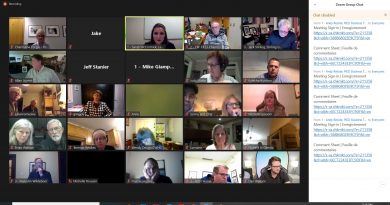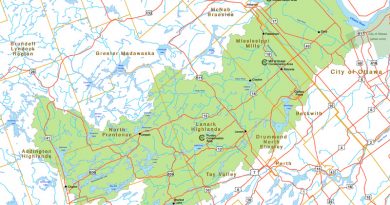FBL: Province needs to rein in aggregate industry
Special to WC Online
The following op-ed piece was submitted by Friends of the Burnt Lands chair and Corkery resident John Blais.
OPINION – For years now, the aggregate industry in Ontario has operated with total impunity. Aggregate, i.e. gravel extracted from pits and quarries, is an essential material for constructing and maintaining our built environment, yet this non-renewable resource is being heavily over exploited by an out-of-control industry.
These materials are strip-mined, with loose aggregates being dug out from pits, and solid bedrock materials blasted from quarries.
The extraction of aggregates radically transforms landscapes, temporarily or permanently altering woodlands, wetlands and farmland. The ongoing operation of a pit or quarry with its heavy-duty truck traffic also has negative impacts on the surroundings, including noise, vibration (from blasting) and air pollution (including hazardous particulates). Additionally, there is a risk from ‘flyrock’ (chunks of rock accidentally ejected from a blast) and the inevitable effect on the local water table.
On Dec. 6, the Auditor General of Ontario released a Value-for-Money Audit of the Management of Aggregate Resources in the province. This 57-page comprehensive report reveals legal violations are rampant in the aggregate industry, and the provincial government is failing to protect lives and the environment from the devastating impacts of gravel mining.
As if the Greenbelt fiasco wasn’t a big enough threat to the natural environment, this report reveals an industry that’s destroying more and more forest and farmland, not to serve the actual demand for aggregate, but to feed corporate ambition and greed. All this is happening without the level of oversight the Ministry of Natural Resources and Forestry (MNRF) is mandated to provide. Existing policy, laws and regulations, (some of which appear to have been dictated in part by the industry itself), are routinely ignored with no consequences.
MNRF is responsible for administering the Aggregate Resources Act (Act). This requires it to facilitate the extraction of aggregates to meet demand, while at the same time regulating aggregate operations to minimize social and environmental impact. The act also requires operators to rehabilitate the lands used for aggregate extraction.
Pits and quarries must be licensed by MNRF and the licenses spell out a number of things for each location including the maximum tonnage of material that may be mined each year, but MNRF also issues licenses for unlimited annual amounts. New license applications must be accompanied by detailed plans generated by highly paid consultants and these plans inevitably show the operation will cause no significant social or environmental damage. This is essentially ‘green-washing.’
Here are the auditor general’s key findings:
1.MNRF’s Lack of experienced aggregate inspectors means operations are rarely visited
MNRF is required to inspect pits and quarries regularly to ensure compliance with the Aggregate Resources Act. As of May 2023, there were only 34 designated inspectors across the entire province, with nine of the 18 districts having either one inspector or none.
Almost half (41 per cent) of the 34 inspectors had held their designation for less than one year. Further, while there were 22 inspectors in 2022, only 16 conducted any field inspections that year. Only 35 per cent of the sites reviewed had been inspected within the previous five years.
2. Evidence points to a significant oversupply of aggregates
Complete and accurate information on the supply and demand for aggregates has not been provided by MNRF. As a result, many stakeholders have concluded, based on available data, there is an oversupply of aggregates already approved for extraction. Estimates of the excess range from 13 times actual demand to 30 times.
3. Violations are widespread in the aggregate industry
The aggregate industry has high rates of non-compliance. From 2018 to 2022, inspectors filed 1,750 reports that identified non-compliances. Cases of non-compliance are rarely referred for further enforcement. Ministry policy dictates that where operators significantly exceed their allowable extraction limits, charges should be pursued. Yet, even in instances where operators had exceeded extraction limits by more than 1,000 per cent, the ministry did not investigate or charge.
4. Industry self-reporting is failing
Aggregate license holders are required to self-inspect their operations to assess whether they comply with legal requirements and submit an annual compliance assessment report to the ministry by Sept. 30 of every year. As of May of 2023, 25 per cent of all 1,030 licensed operators had not submitted a 2022 report.
5. There is no process in place to ensure pits and quarries are rehabilitated
The Province of Ontario considers aggregate extraction an interim use of land and requires operators to file detailed rehabilitation plans with MNRF. But an aggregate site may remain open for decades, and in some cases, sites have been operating for more than a century. Operators actually have little incentive to rehabilitate damaged land.
6. The MNRF’s current program for managing aggregate resources is financially and environmentally unsustainable
There is a huge shortage of inspectors and no mechanism to enforce regulations. At the same time, the aggregate industry is whining about too much ‘red tape.’
There are 110 licensed pits and quarries within the City of Ottawa, covering an area of 4072 hectares (more than 10,000 acres). Of the 110, 22 pits and quarries lie in West Carleton. Most of these are hidden by large berms so they go unnoticed by the public. Note that 22 pits and quarries in Ottawa have licenses for unlimited annual extraction (It’s not clear why no limit is placed on some licenses). However, even the total annual licensed extraction limit is a whopping 45,509,000 tonnes.
In short, the City of Ottawa has plenty of aggregate already licensed for extraction and it should refrain from rezoning more land for aggregate mining until an updated study of resources can be completed. The Province of Ontario should likewise decline to process new pit and quarry license applications until the laws and regulations can be updated to better reflect changing environmental awareness.












Well, that’s an eye-opener. I wonder how many area residents are aware of this, or how many of our elected officials are even aware.
Fabulous article, John. Keep going!
Dan